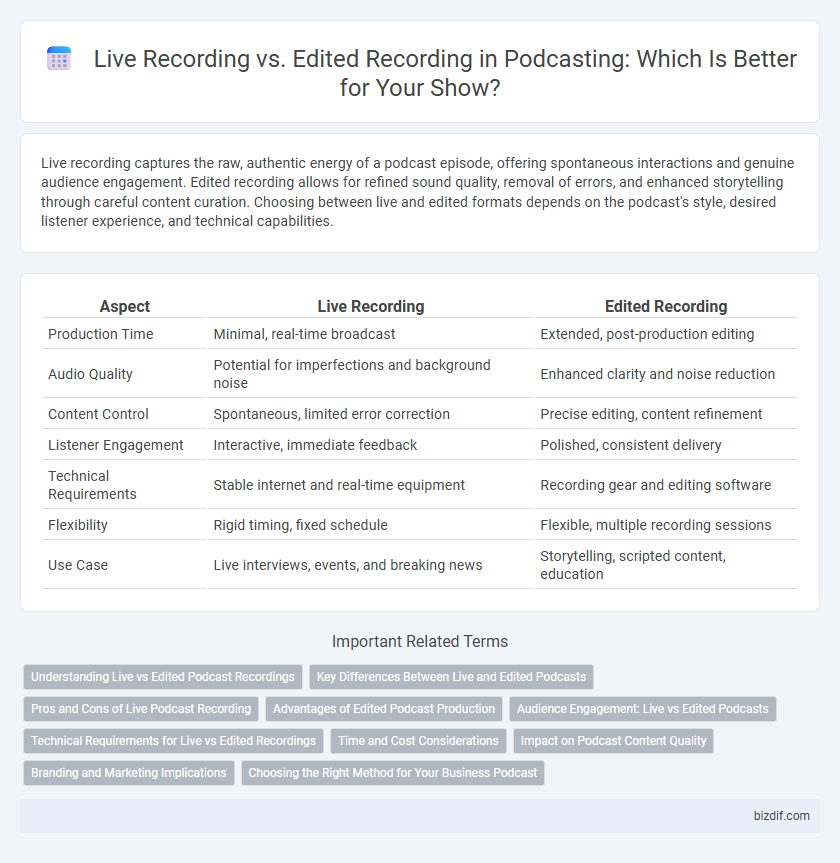Live recording captures the raw, authentic energy of a podcast episode, offering spontaneous interactions and genuine audience engagement. Edited recording allows for refined sound quality, removal of errors, and enhanced storytelling through careful content curation. Choosing between live and edited formats depends on the podcast's style, desired listener experience, and technical capabilities.
Table of Comparison
| Aspect | Live Recording | Edited Recording |
|---|---|---|
| Production Time | Minimal, real-time broadcast | Extended, post-production editing |
| Audio Quality | Potential for imperfections and background noise | Enhanced clarity and noise reduction |
| Content Control | Spontaneous, limited error correction | Precise editing, content refinement |
| Listener Engagement | Interactive, immediate feedback | Polished, consistent delivery |
| Technical Requirements | Stable internet and real-time equipment | Recording gear and editing software |
| Flexibility | Rigid timing, fixed schedule | Flexible, multiple recording sessions |
| Use Case | Live interviews, events, and breaking news | Storytelling, scripted content, education |
Understanding Live vs Edited Podcast Recordings
Live podcast recordings capture authentic, unfiltered conversations, fostering real-time engagement and spontaneity that resonate with listeners seeking genuine interaction. Edited recordings, however, enhance audio quality by removing errors, background noise, and awkward pauses, resulting in a polished, professional sound that appeals to audiences valuing clarity and conciseness. Choosing between live and edited podcast formats depends on balancing immediacy with production quality to meet specific audience preferences and content goals.
Key Differences Between Live and Edited Podcasts
Live podcast recordings offer real-time interaction and unfiltered authenticity, capturing spontaneous moments and audience engagement. Edited podcasts enhance sound quality, remove errors, and allow for refined storytelling through post-production techniques like trimming, sequencing, and effects. The choice depends on whether immediacy and raw energy or polished content and clarity are prioritized in the podcasting approach.
Pros and Cons of Live Podcast Recording
Live podcast recording captures authentic, spontaneous conversations that engage listeners with real-time energy and unrehearsed moments, fostering a genuine connection. However, it carries risks such as technical glitches, background noise, and limited control over content quality or errors, which can impact the polished feel of the episode. This format suits podcasters prioritizing immediacy and interaction but demands confidence in managing unpredictability without post-production corrections.
Advantages of Edited Podcast Production
Edited podcast production enhances audio quality by removing background noise, pauses, and mistakes, resulting in a polished and professional sound. It allows for seamless integration of sound effects, music, and interviews, improving listener engagement and storytelling. Editing also provides flexibility to structure episodes for clarity and pacing, making content more accessible and enjoyable.
Audience Engagement: Live vs Edited Podcasts
Live podcast recordings create a sense of immediacy and authenticity that can significantly boost audience engagement by allowing real-time interaction and spontaneous moments. Edited podcasts, while polished and refined, often deliver clearer content and a more structured narrative that appeals to listeners seeking a seamless experience. Understanding the target audience's preference for either dynamic, unpredictable broadcasts or carefully curated episodes is key to maximizing listener connection and retention.
Technical Requirements for Live vs Edited Recordings
Live recording demands low-latency audio interfaces, reliable high-speed internet for streaming, and robust noise-canceling microphones to minimize real-time disruptions. Edited recordings benefit from multi-track recording setups, high-capacity storage solutions, and advanced DAW software for precise post-production enhancements. Both approaches require quality headphones and audio monitoring tools, but live sessions prioritize real-time processing, while edited recordings emphasize flexibility in sound editing and mixing.
Time and Cost Considerations
Live podcast recording significantly reduces production time and editing costs by capturing content in a single session with minimal post-processing. Edited recordings require additional time for cutting, sound leveling, and error correction, increasing both labor and software expenses. Choosing live recording optimizes resources, making it ideal for tight schedules and limited budgets.
Impact on Podcast Content Quality
Live recording captures authentic energy and spontaneity, preserving raw interactions that enhance listener engagement and emotional connection. Edited recording allows for meticulous control over sound quality, pacing, and content clarity, resulting in a polished and professional-sounding podcast. Balancing live authenticity with post-production refinement significantly impacts overall podcast content quality and audience retention.
Branding and Marketing Implications
Live recording in podcasting creates an authentic brand image by showcasing real-time interactions, which enhances audience trust and engagement. Edited recordings allow for polished content that reinforces a professional brand identity and supports targeted marketing strategies through precise messaging. Choosing between live and edited formats impacts audience perception, retention, and overall brand positioning in competitive markets.
Choosing the Right Method for Your Business Podcast
Live recording captures authentic, real-time interactions, fostering genuine audience engagement and immediate feedback, making it ideal for businesses seeking spontaneity. Edited recording allows precise content control, polished sound quality, and the ability to remove errors or lengthy pauses, enhancing professionalism and clarity for brand messaging. Selecting the right method depends on your business goals, target audience preferences, and resources for post-production.
Live recording vs edited recording Infographic

 bizdif.com
bizdif.com